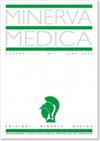Incidence and risk factors for non-cardiac syncope in a cohort of patients addressing an accredited Arterial Hypertension Center: the Innocent Study.
IF 4.7
4区 医学
0 MEDICINE, GENERAL & INTERNAL
引用次数: 0
Abstract
BACKGROUND Hypotensive susceptibility in hypertensive patients could facilitate orthostatic hypotension, syncope and fall. The aim of this study was to identify incidence, clinical form, complications and risk factors for non-cardiac syncope in a cohort of hypertensive patients. METHODS This is an observational, case-controlled, retrospective study carried out on 168 patients, evaluated at the Hypertension Center of the University Hospital of Parma (Italy). Based on the presence of episodes of syncope during the six months prior to enrolment, we identified cases and controls and then we compared them to personal data, comorbidities, current drug regimens, presence of orthostatic hypotension, office and ambulatory blood pressure monitoring (ABPM) blood pressure (BP) values. RESULTS In patients with previous syncopal episodes (29.8% of total), we more frequently found female gender, comorbidities associated with autonomic dysfunction, diuretics and non-CV drugs potentially associated with hypotension in their current drug regimen, orthostatic hypotension and lower office and ABPM BP values. CONCLUSIONS To identify hypertensive patients at higher risk for syncope and falls, physicians should focus on comorbidities and current drug regimens, systematically perform an active standing test to identify orthostatic hypotension, employ ABPM to compare BP values with the pre-established target and highlight systolic BP drops and abnormalities suggesting concomitant autonomic dysfunction. The modulation of antihypertensive therapy is an effective tool to counteract the risk of non-cardiac syncope, with possible trauma or other negative influences.在经认可的动脉高血压中心就诊的一组患者中,非心源性晕厥的发生率和风险因素:无辜者研究。
背景高血压患者的高血压易感性可导致正性低血压、晕厥和跌倒。本研究旨在确定高血压患者队列中非心源性晕厥的发病率、临床形式、并发症和风险因素。方法这是一项观察性、病例对照、回顾性研究,研究对象是意大利帕尔马大学医院高血压中心的 168 名患者。根据患者在入院前六个月内是否发生过晕厥,我们确定了病例和对照组,然后将其与个人数据、合并症、当前用药方案、是否存在正性低血压、诊室和流动血压监测(ABPM)血压(BP)值进行了比较。结果在既往有晕厥发作的患者(占总人数的 29.8%)中,我们更常见的是女性、与自主神经功能障碍有关的合并症、利尿剂和当前用药方案中可能与低血压有关的非氯化物药物、正性低血压以及较低的诊室血压和 ABPM 血压值。结论为识别晕厥和跌倒风险较高的高血压患者,医生应重点关注合并症和当前的药物治疗方案,系统地进行主动站立测试以识别正性低血压,采用 ABPM 将血压值与预先设定的目标值进行比较,并重点关注收缩压下降和提示伴有自主神经功能障碍的异常情况。调整降压治疗是抵御非心源性晕厥风险的有效工具,可能会造成外伤或其他负面影响。
本文章由计算机程序翻译,如有差异,请以英文原文为准。
求助全文
约1分钟内获得全文
求助全文
来源期刊

Minerva medica
医学-医学:内科
CiteScore
6.40
自引率
6.40%
发文量
358
审稿时长
>12 weeks
期刊介绍:
Minerva Medica publishes scientific papers on internal medicine. Manuscripts may be submitted in the form of editorials, original articles, review articles, case reports, special articles, letters to the Editor and guidelines. The journal aims to provide its readers with papers of the highest quality and impact through a process of careful peer review and editorial work. Duties and responsibilities of all the subjects involved in the editorial process are summarized at Publication ethics.
 求助内容:
求助内容: 应助结果提醒方式:
应助结果提醒方式:


